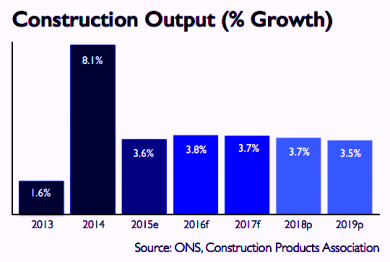Osborne spurs house builders to deliver 400,000 homes
Chancellor George Osborne attempted to galvanise reluctant house builders into delivering more homes with a £6.9bn package of measures.
Critically the affordable housing package in the combined Autumn Statement and Spending Review includes cash to stimulate the supply-side and demand-side of the housing sector.
He also said transport capital spending would be raised to fund HS2 and the roads programme as the department’s operational budget was slashed by 37% but its capital spending will increase as previously planned by 50% to £61bn, compared to the last five-year period.
“That funds the largest road investment programme since the 1970s, for we are the builders,” added Osborne.
The funding includes starting construction on High Speed 2, and sticking to plans to spend £13.4bn on the Roads Investment Strategy to deliver 112 major schemes and over £5bn on roads maintenance.
Up to £475m will be released towards the end of five years to fund large local transport projects, enabling local areas to bid for funding for projects that would be too expensive for them to pay for by themselves, such as the Lowestoft Third River Crossing and the North Devon Link Road.
The Government has ramped up spending on the school estate and committed to spend £23bn over the Parliament to open 500 free schools, provide over 600,000 additional school places, rebuild and refurbish over 500 schools and address essential maintenance needs.
Spending Review other key points
New £300m Transport Development Fund, supporting development work for projects like Crossrail 2
Apprenticeship levy will be set at 0.5% of an employers wage bill
£1.3bn to reform prison estate by building nine prisons
£310m for 15,000 homes at Ebbsfleet garden city
£400m to build new integrated public health science hub in Harlow
Creation of 25 enterprise zones
Council free to raise business rate to fund infrastructure and spend all capital receipts from asset sales
£150m for a new dementia research institute at a UK university site
£150m to build new storage facility for the British Museum, Science Museum and Victoria and Albert Museum
£97m Thameslink station at Brent Cross
Extra £250m for Kent transport
Fund new home for Royal College of Arts in Battersea
| Infrastructure investment £billion | |||||||
| Year | 15-16 | 16-17 | 17-18 | 18-19 | 19-20 | 20-21 | Total |
| Existing long term capital plans | |||||||
| Roads Investment Strategy | 1.8 | 1.8 | 2.2 | 2.5 | 3.0 | 3.9 | 15.2 |
| Highways maintenance | 1.0 | 1.0 | 1.0 | 1.0 | 1.0 | 1.0 | 6.9 |
| Network Rail | 6.8 | 7.4 | 5.6 | 4.3 | 5.0 | 5.3 | 34.5 |
| High Speed | 0.8 | 0.8 | 1.7 | 2.9 | 4.8 | 4.8 | 15.8 |
| Flood/coastal defence | 0.4 | 0.4 | 0.4 | 0.4 | 0.4 | 0.4 | 2.3 |
| Science: capital | 1.1 | 1.1 | 1.1 | 1.2 | 1.2 | 1.2 | 6.9 |
| Housing and regen plans | 1.0 | 1.0 | 1.0 | 1.0 | 1.0 | 1.0 | 5.9 |
| Existing school building plans | 4.6 | 4.8 | 3.8 | 3.2 | 3.0 | 2.8 | 22.2 |
| New extra spend | |||||||
| Housing and regeneration | – | 0.0 | 0.3 | 1.2 | 1.1 | 1.4 | 4.1 |
| Local Sustainable Transport Fund | – | 0.1 | 0.1 | 0.1 | 0.1 | 0.1 | 0.5 |
| Large Local Major Roads | – | 0.0 | 0.0 | 0.0 | 0.1 | 0.3 | 0.5 |
| New school building plans | – | 0.3 | 0.8 | 1.3 | 1.5 | 1.8 | 5.7 |
| Total spend | 17.5 | 18.7 | 18.0 | 19.1 | 22.1 | 23.9 | 120.4 |
On housing he added: “First I am doubling the housing budget to £2bn a year and will deliver 400,000 new homes by the end of the decade. That is the biggest house building programme since the 70′s.”
Full details have still to emerge but the spending package includes direct subsidies of up to £2.3bn to developers to spur them into building 200,000 starter homes — properties for sale to first-time buyers at a 20% discount to their market value.
The new starter homes discount policy first announced in October 2014 will be available on prices up to £450,000 in London and £250,000 elsewhere.
On the demand-side up to £4bn will be channeled into building 135,000 Help to Buy: Shared Ownership homes for households earning less than £80,000.
In London, this threshold will stand at £90,000. The Chancellor also launched the London Help to Buy scheme, which will provide interest free loans on up to 40% of loans.
A further £400m is earmarked to help build 8,000 specialist homes for older people or those with disabilities.
Up to £200m has been found for 10,000 new homes that tenants can live in for five years at reduced rents while they save for a deposit. They will then have “first right” to buy the home.
This story is by constructionenquirer.com
Edge Careers are Construction and Engineering Recruitment Experts who pride ourselves on offering the highest level of service in the industry to all of our candidates and clients.
To become an Edge Careers candidate, please click here to register your details. If you are a client looking to fill a vacancy, please click here, or alternatively contact one of our consultants to discuss your requirements in more detail via our Contact Us page.
Follow Edge Careers on LinkedIn, Twitter and Facebook for all our latest news, exclusive competitions and events.









